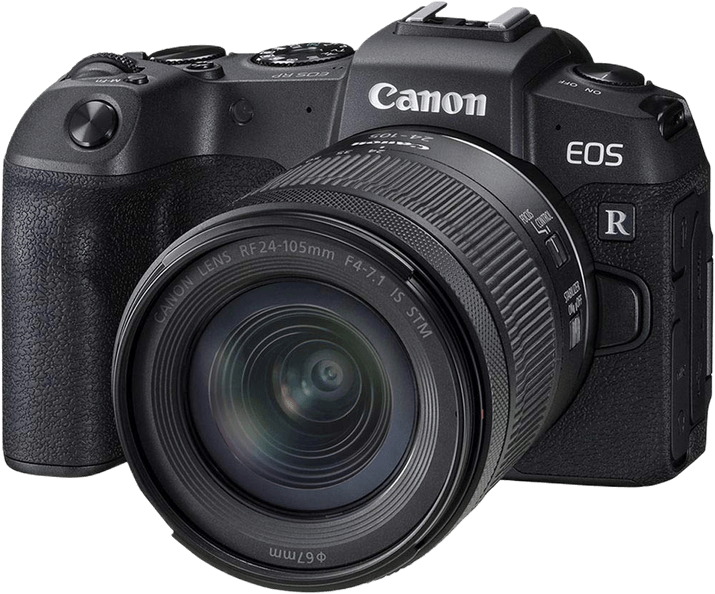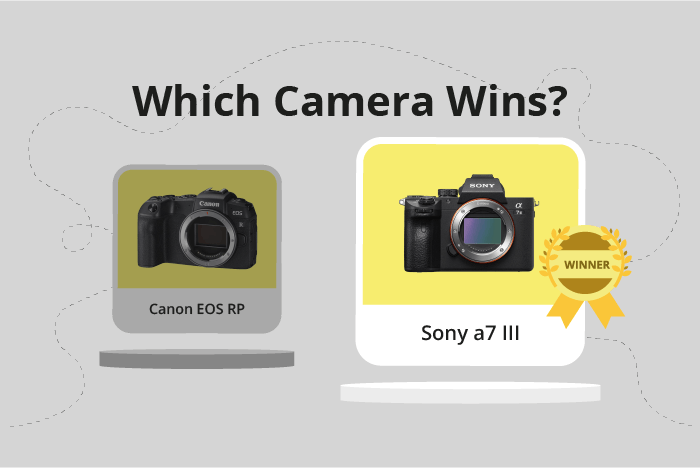Canon EOS RP vs Sony a7 III Comparison
Canon EOS RP

Sony a7 III

The Sony a7 III outperforms the Canon EOS RP with a score of 81 compared to 65/100. Both cameras are mirrorless and were released within a year of each other, with the Canon EOS RP launching in 2019 and the Sony a7 III in 2018. They share similar dimensions, but the Sony a7 III is heavier at 650g compared to the Canon EOS RP’s 440g.
The Sony a7 III’s higher score signifies its superior performance and features, justifying its higher launch price of $2000 compared to the Canon EOS RP’s $1300. However, the Canon EOS RP’s lower weight makes it a more portable option for those prioritizing mobility.
When considering these cameras, the Sony a7 III is the better choice for photographers seeking top-notch performance, while the Canon EOS RP may appeal to users who value a lighter and more affordable camera.
Canon EOS RP vs Sony a7 III Overview and Optics
The Sony a7 III outperforms the Canon EOS RP in optics, earning a score of 81 out of 100, compared to the Canon’s 67. Both cameras share several specifications, such as having a CMOS sensor, a full-frame sensor size, and similar megapixel counts (26 for Canon and 24.2 for Sony). Additionally, both cameras utilize their respective lens mounts, with the Canon using the Canon RF mount and the Sony using the Sony FE mount.
The Sony a7 III excels in its shooting speed, boasting 10 frames per second, which is double the Canon EOS RP’s 5 frames per second. The Sony also has a higher DXOMARK score for its sensor, at 96 compared to the Canon’s 85. This indicates better overall image quality. Furthermore, the Sony a7 III features image stabilization, providing steadier shots and reducing the need for a tripod or other stabilization tools.
Despite its lower score, the Canon EOS RP has a slightly higher megapixel count of 26, compared to the Sony’s 24.2. This means the Canon can produce slightly larger images and offer more flexibility in cropping and printing. However, this advantage is minimal and may not be significant for most users.
When considering the optics of these two cameras, the Sony a7 III emerges as the stronger contender due to its faster shooting speed, better sensor performance, and image stabilization feature. While the Canon EOS RP has a minor advantage in megapixels, the overall optics performance of the Sony a7 III is superior, making it the better choice for those prioritizing image quality and performance.
Canon EOS RP vs Sony a7 III Video Performance
The Canon EOS RP and the Sony a7 III have similar video capabilities. Both cameras share some common specifications, such as 4K max video resolution and 3840 x 2160 max video dimensions.
The Canon EOS RP has a maximum video frame rate of 25fps, while the Sony a7 III offers a slightly higher frame rate of 30fps. Both cameras have built-in time-lapse functionality. This feature allows users to create stunning time-lapse videos without the need for additional equipment or software, making it a more versatile option for videographers.
Canon EOS RP vs Sony a7 III Features and Benefits
The Sony a7 III wins the features comparison with a score of 81/100, while the Canon EOS RP scores 70/100. Both cameras share several specifications, including a 3-inch screen size, touchscreen capabilities, flip screen, absence of GPS, and the presence of WIFI and Bluetooth connectivity.
The Sony a7 III outperforms the Canon EOS RP in certain aspects. For instance, its screen resolution is higher at 921,600 dots compared to the Canon EOS RP’s 1,040,000 dots. This difference in resolution provides users with a clearer and sharper image preview, which can be crucial for composing and reviewing shots.
On the other hand, the Canon EOS RP has its advantages as well. Despite having a lower overall feature score, it still offers a robust set of features that cater to various photography needs. Additionally, the Canon EOS RP may be more affordable for some users, making it a more attractive option for those on a budget.
Taking all these factors into account, the Sony a7 III is the better camera in terms of features. Its higher score reflects its superior performance in areas such as screen resolution. However, the Canon EOS RP remains a competitive option for those who prioritize affordability or are loyal to the Canon brand. Ultimately, the choice between these two cameras depends on individual preferences and requirements, as both cameras offer a strong set of features to satisfy a wide range of photography enthusiasts.
Canon EOS RP vs Sony a7 III Storage and Battery
The Sony a7 III outperforms the Canon EOS RP in storage and battery with a score of 68/100, compared to the Canon’s 29/100. Both cameras accept SD/SDHC/SDXC memory cards, but the Sony a7 III also supports Memory Stick Duo/Pro Duo/Pro-HG Duo cards and has two memory card slots, while the Canon EOS RP has only one slot and is UHS-II compatible.
The Sony a7 III’s battery life of 750 shots is significantly longer than the Canon EOS RP’s 250 shots, using an NP-FZ100 battery type. However, the Canon EOS RP has the advantage of USB charging, which the Sony a7 III lacks.
Considering these factors, the Sony a7 III offers superior storage capabilities and battery life, making it the better choice for extended shooting sessions and flexibility in memory card options. The Canon EOS RP’s USB charging feature is a plus, but it does not outweigh the advantages of the Sony a7 III in this comparison.
Alternatives to the Canon EOS RP and Sony a7 III
Are you still undecided about which camera is right for you? Have a look at these popular comparisons that feature the Canon EOS RP or the Sony a7 III:

